The Logitechs:
Last year I installed three Logitech Alert IP (web) cameras around our desert home. The first was a 750e master exterior system at the NW corner of the deck under the shower roof overhang of our new solar utility house, looking south. I am defining that location because we go through three different cameras in that position.
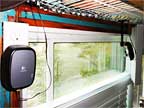
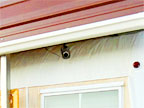
The second was a 700i indoor extension unit inside our 1940's Branstrator Trailer looking out the window at the area unseen by the 750e, our front yard and most of the driveway. This turned out to be a bad spot for the camera. Every time a fly moved on that window, it triggered a snapshot email and a recording to the hard drive. Also, at night the window turns into a mirror. Although a short curtain did hang behind the camera, any movement captured below the curtain triggered a snapshot and recording, meaning it also captured any conversations that occurred during that recording.
Eventually, I moved that camera outdoors, up and under the carport roof, still looking over front yard. This turned out to be a much better vantage point. It also makes the camera and its red power light more apparent to anybody casing the joint.
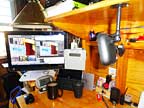
The third was another 700i inside the utility house looking at the computer, a digital Rain Alert Ultrasonic Tank Level meter, an Outback Solar Power MATE3 System Display, and the room in general. That computer stays on 24/7 and can be remotely controlled from anywhere else using TeamViewer. The camera allows me to see and hear what I would see and hear if I were sitting in that office chair.
Off The Grid:
I should explain that our place is totally "off-the-grid". We get our power from the sun. We use a compost toilet so we have no waste requiring a septic tank or county disposal system. Our water is delivered by truck, which is probably not as ecological as having it delivered by pipe. We refill our numerous propane tanks in town, which keeps us warm and heats our water. We drive a Prius, minimizing our fuel consumption. We do this because we can and we should. I am a technology nut and love being able to figure this all out and make it work. I am also an ecology nut and am very pleased that we can make this contribution to our planet. I was recycling everything back when there were no laws requiring it.
Do not mistake our independence for having any relationship with the belligerent right-wing anti-government people. I am very grateful that our government provides the services that it does, in spite of the inherent waste that results from the mass-cooperation of millions of willing and unwilling participants. We must work together (compromise) so that our system can do what it needs to do. That is what makes our society work, which is absolutely necessary for the survival of humanity in the long run. With extreme climate change happening right now, we need our governments to get control of the powerful and self-serving interests that are causing it, who are represented by the right-wing uncompromising politicians that need to be voted out before they kill us all.
It is interesting, and scary, to read
the recent scientific conclusions that the massive 600 year old Mayan civilization was indeed wiped out by the very same short-sighted thinking. They created their own climate change.
The System That Worked:
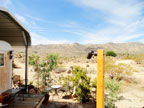
The Logitechs produce a very nice image with excellent color rendition and good clarity, though not as good as that of the digital camera that I carry around in my pocket. Since the Logitechs can store full before and after videos of all triggered events on the computer, the resolution has to remain relatively low so as not to overload the hard drive with high-res videos that require an enormous amount of space to store their millions of pixels, each.
In other words, I can take any photo from my high-res digital camera and expand it to full resolution on my computer screen to see reasonably sharp details within any small portion of that photo. A Logitech photo will initially look almost as nice on the screen but if expanded to the same degree, one would see a screen full of irregular blurs.
From the 750e I could see a nice wide view of the deck and the trailer, the patio and its pond, the trees and plants with a water spigot at each, the road, valley and mountain range beyond. Every Wednesday and Saturday at 3 PM, a pump kicks on to distribute a low flow of pond water to each of the spigots for 10 minutes. The pond in turn refills itself from the water tank up on the hill. 3000 miles away, I like to watch all that happen now and then just to make sure everything is working as it should. Even though the Logitech can digitally "zoom" into just the patio area, it is difficult to determine whether or not water is flowing from those spigots. At 3 PM, I might catch the sky's reflection on the flow of water.
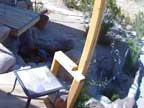
I had originally set the pump to run at 8 AM twice a week, but that put the spigots in shadow and impossible to see from the Logitech. However, the sound rendition is excellent so if I listened carefully, I could hear the spigots gurgle as they kicked on, and again as they shut off.
This is the main reason for the camera being placed in that location to begin with.
The System That Stopped:
When the Brinks 44-1030 7-day Programmable Timer got stuck in the ON position at 8:10 AM on Saturday, July 2, the pond continued to empty. Hence, the re-filler remained on until the 2600 gallon water tank also emptied out. I did not know this was happening.

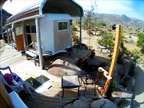
Our friend Stephanie happened to walk by that afternoon to feed our neighbor's cat. She heard a loud strange sucking noise coming from our pond and sent me an email that night.
I had been watching the camera and suspected that something was not quite right, but I had no clue as to what. The pond seemed to be low, but maybe the refiller was slowing down; clogged with algae or something. I had just gotten the tank filled, so it could not be out of water. This dilemma was compounded by my being unable to clearly read the digital water meter (like that of a sideways cell phone) which at that time was about 5 feet from the camera. It reflected the sky, making the bars nearly invisible.
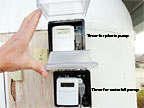
It never occurred to me that a digital timer could get stuck. Digital means totally electronic; no moving parts. But through emails and phone calls we deduced what might be happening. On Monday, she and her friend Dave shut the timer off which turned off the pump and stopped the noise. They dragged a hose over from the neighbor's house and refilled the pond.
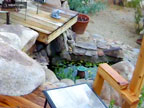
On Wednesday, Wonder Water of 29 Palms refilled the tank. On Thursday my neighbor Tom, now returned home, replaced the old timer with a new one.
They also set this new timer to kick on at 3 PM so that I could watch it in the afternoon sun.
Hands On PTZ:
I returned in October and quickly order the second 700i mentioned above, installed in the utility house facing the computer and also facing the water meter which I had moved inside and which was now clearly visible from this camera.
I also bought Stephanie and Dave a $120 credit at a local coffee house,
The Natural Sisters Cafe.
In March I happened upon, purchased and installed the Blue Iris software which far surpasses the capabilities and sophistication of any manufacturers' software that I have used. I still have to revert to the Logitech software, or their remote browser app, to digitally zoom the camera, but otherwise Blue Iris is much nicer to work with. Blue Iris does have a zoom capability, but it does not work with the Logitech's proprietary pseudo-zoom function.
I had concluded that my most pressing need now was to get a 360 degree view. This function is commonly referred to as pan/tilt/zoom (PTZ). No Logitech cameras had this capability. At first I hoped to find a remotely operated PTZ mount to which I could attach my 750e, but for various reasons this turned out to be unfeasible, if only because the 3.5 pound 750e is too heavy for such a mount. FYI, the Eagletron TrackerCam mount and its software and the tech support appear to be very good.
I of course was also seriously interested in a better zoom function; one that would allow me to zoom right in on the water spigots, but those webcams with a respectable optical (not digital) zoom that would meet my needs turned out to be extraordinarily expensive and I was not ready to spring for that - yet.
It was not easy choosing a good PTZ because the reviews were not comparing them to the quality of the Logitech Alerts. I was really considering an entirely different kind of camera. I concluded that I simply needed to learn hands on, and then perhaps go to something better and more expensive. In March I finally settled on a reasonably priced PTZ camera that was getting good reviews.
I ordered the "Loftek Sentinel-D1 Wireless IP Camera Pan/tilt 3x zoom Wifi Waterproof Outdoor And Indoor Dome Internet Surveillance Camera". Really! That is the full name of the camera on Amazon. No software is included except for an "IP Camera Tool" (C:\Windows\SysWOW64\IPCamera.exe) that helps it find itself, and a good PDF of instructions.
I hung the Loftek next to the 750e, but out where that 360 degree range could get some useful shots most of the way around, though about 90 degrees of that was of the utility house shower wall. Setup of the camera is done in a browser. That worked okay; nothing fancy or complicated; just basic controls. I established the 8 preset positions. You define a preset by pointing the camera in a particular direction and saving that position as a preset. I did everything else in Blue Iris.
I use Microsoft's Internet Explorer browser for all local and remote camera setup with "Delete browsing history on exit" checked so as not to accumulate a cache of old stuff that can slow things down. I use Firefox for all other browsing where I like my history to remain available.
Juggling Cameras:
I then moved the Logitech 750e camera to the highest point above the utility house roof, above the solar panels, including a custom made bracket that projects it up another 5 inches so that it can get the maximum view of the entire area over the roof tops.


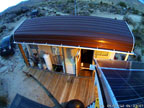

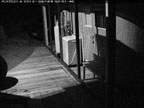
This turned out to be an excellent vantage point for this 130 degree wide angle view. Even that high up, the Logitech's infrared feature does a real nice job of lighting up the entire deck and trailer/carport below at night. This IR also lights up everything for the other cameras too, allowing them to see that area from their viewpoints.
The Loftek's resolution is not as good as the Logitech's, but it does allow me to remotely point the camera in any direction. It can also be set to pan (patrol) all presets continuously back an forth.
Ultimately, as expected, I was not satisfied with the quality or resolution of the Loftek. It allowed me to look in nearly any direction but it was unable to zero in on the details of any particular spot, such as water flowing from a spigot.
Will Bigger Money Get A Better PTZ?
I decided to spring for an expensive one that for the price should do everything right. Un-huh. I found a relatively good deal on a refurbished "Axis 214 PTZ Network Camera Pan Tilt Zoom Day/night 2 Way Audio", a $1220 camera for $900 that was getting fairly good reviews.
When it arrived, it did not work. I deduced that it has a bad power supply. I emailed AXIS and they immediately sent me a new power supply, no charge. It worked.
Great service.
However, the first thing I noticed was that the picture quality sucked compared to the Logitech and even the Loftek. I could not believe this. All that money for this?
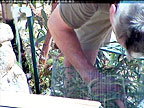
On the other hand the 18x optical zoom resolution was exceptionally nice, presumably equal to an 18x telescope. It had no problem getting up and close with my water spigots. I can zoom to the highway a mile below and watch the cars and bikes going by. I can even zoom to the mountain range across the valley and observe the line of railroad cars that go nowhere, or to the cell tower above and to the right. This is pretty cool.
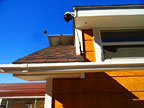
I moved the Loftek around back to where it can watch the hillside that the nearby Logitech, pointing in the opposite direction, can't see. I installed the Axis in its place.
The browser based Axis software is exceptionally complicated and slow and it is buggy in spots. I have learned that when I make a change and everything still works, to stop and back up my settings. This is very time consuming, but occasionally some change will throw things out of whack, even loosing my carefully defined "Guard Tour" (pan; patrol) that I have diligently assembled and tweaked. The backup process is very slow, but it gets the settings back.
The extensive documentation is inadequate. Using many non-intuitive technical terms, some settings are not explained well enough to keep me from making a change that turns out to be wrong relative some other features. Their support people seem to be accomplished enough to figure that out for me, and yet their techs are claiming that they no longer support this new camera. Oh? I am referring to a glaring bug in the software that they presumably use for all Axis PTZ cameras.
PTZ Presets:
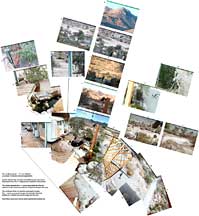
The Axis software allows this camera to have 20 presets, compared to Loftek's 8 presets. Blue Iris is also technically 8 but it appears as though that number is beginning to grow. The author of Blue Iris is constantly improving the software, so it continues to be basically flawless. Where a problem turns up, he fixes it. Logitech does likewise on occasion, but not Axis and not Loftek. The Loftek people do respond, but English is clearly not their first language.

By the way, though Axis allows 20 presets, you can only use 19; you have to keep one free for making adjustments to a preset, such as a rename. To rename a preset, you absolutely must not just rename it. Really! You have to create it as a new preset and then delete the old one. Actually, it will in fact allow you to simply rename a preset and it raises no objection, but then other aspects of the software suddenly go nuts because they didn't get the message. However they do seem to get outright creations and deletions, so you have to keep a blank preset free for that. The Loftek does not have this problem.
I am beginning to suspect that it may be a good idea to avoid dealing with the older established companies like Axis who have an enormous and confusing number of camera models on the market. They are too set in their old ways. Their unwieldy browser app is probably bloated with camera additions and bug fixes, etc..
In Blue Iris, all of my stationary Logitechs are set to trigger an email when motion is detected, where masks and sensitivity can be carefully refined to block most moving branches and late afternoon shadows. Blue Iris does a better job of this then the included software.
However, with the PTZ cameras and their multiple views, this can be tricky. For the Loftek I have established two "profiles" in Blue Iris, which allows up to seven completely independent profiles per camera. One covers the bulk of the day with settings similar to those of the Logitech. The second profile begins in the late afternoon and ends mid-morning where sensitivity and contrast and masking can be refined to handle the deep dark exaggerated moving shadows of trees and flags, etc. that may or may not even be in the picture, but hopefully still catch the movement of warm bodies. Blue Iris includes an option to turn off detection while the Loftek lens is moving from one position to the next so that the movement itself will not trigger anything.
As of yet, I cannot get Blue Iris to recognize the Axis presets. The Blue Iris documentation states that it only works with "presets 1 through 8" and yet it has accepted and does list all 17 that I typed in. However, I was not thinking clearly when I named the presets in the Axis app. I began the first nine presets with a zero, such as 01, 02, 03, etc. and I now understand that Blue Iris is looking for the numbers 1 through 8; not 0's.
When I return there two or three months from now, I will make those changes. When I do so, I suspect that Blue Iris will be able to work with the first 8. I can only hope that it will also work with the remaining 11, but I suspect not. We will see. However, if it does not, I have noticed that when I mention by email a problem or preference to Ken Pletzer, the author, a fix usually appears in a subsequent iteration. Nice!
As mentioned above, I use TeamViewer to work on the remote computer 3000 miles away. Though its response time is usually slow due to internet speeds, TeamViewer is reliable. The only real problem I have had is remembering to adjust the computer's settings such that it's hard drive never falls asleep. The monitor does not matter; just the drive.
Another discovery was that neither PTZ Setup in the Internet Explorer browser would work remotely in TeamViewer. A click on Setup or Sign In got nothing. I finally figured this out. Under Security in the Internet Options window, the local address of each camera has to be added to the Trusted Sites list. It is a simple Copy & Paste process.
The Weather:
The Logitech 750e and the Loftek are outdoor cameras. They have no problem with heavy rain and wind. The Axis is not, so stayed safe under a roof until my $365 Dotworkz Dome arrived. That was cheaper then what Axis had to offer and yet it is exceptionally well designed and supported. FYI, when I installed the Axis 214 inside the Dotworkz I left the Axis mounting plate attached to the camera. That was a mistake. You have to remove that plate and use only the one supplied by Dotworkz. Also, the Dotworkz is designed to hang on a wall and needs a 9" square of that wall to hang properly. I was attaching it to a 3.5" wooden roof frame so I had to get creative with a couple of steel straps, bolts and fender washers to make sure it was getting a good solid grip. The adjacent pictures show how that was done.
The Results:
Blue Iris includes another very nice option. Any time the 700i detects movement or hears something in our front yard, I have set Blue Iris to trigger a snapshot from every outdoor camera; not just the 700i. That is cool. It also saves a short 700i video to a dedicated partition on the computer's hard drive. This means that I can minimize the sensitivity of both PTZ cameras in Blue Iris and let the 700i trigger shots from the PTZ cameras instead.
Blue Iris sends all triggered snapshots as attachments which are also shown within the body of the email so that it can be seen at a glance. In my new email handler, Thunderbird, I can whip through those emails very quickly with the down arrow on my keyboard. In MS Outlook, I had to first run an add-on to extract all attachments to an external folder. I described this in last year's camera article.
I study the snapshots at the end of the day and drag any attachments that I want to keep into a Motion folder created for the purpose. When that is done I permanently delete all of those emails.
When that Motion folder accumulates 30 or so images, I run software that I wrote using AutoHotkey(L).exe to distribute shortcuts to appropriate sub-folder categories. Initially these were sorted by time in Thunderbird so that all images from different cameras were grouped together. This took way too much time because I had to study each photo to try and figure out what moved.
Then something in my brain clicked and I changed it to sort by camera name in the Subject heading instead. They are already more or less chronological by default. This allows me to whip through all of the day's snapshots for each camera quickly because anything that moves stands out in comparison to the previous shot of the same scene.
Of course this does not work so well with the PTZ cameras because what they are looking at keeps changing. I am hoping to find a way to add the preset number to the camera name in the Subject column, then they too would sort by scene.
That Motion folder is inside my DropBox folder so that I can get to it from anywhere in the world at any time (after DropBox has completed its automatic upload and subsequent downloads into my other machines and devices that are running, including my wife's iPhone).
While we're at it, I also use Google Drive to store my thousands of photos for the same reason. Google Drive is currently a little cheaper then DropBox. I do not store the triggered videos in either of these places, because the continuous uploads and downloads would become never-ending bandwidth hogs slowing all machines to a crawl. I use TeamViewer to get to a particular video on the distant machine, though I do not run the video in TeamViewer; that would be too slow. Instead, within the TeamViewer window, I drag a copy into the DropBox folder, wait a few minutes, and then run the video on my local computer.
Conclusion:
If I try again to go for an even better PTZ camera, it will probably not be an Axis or a Loftek.
Since Logitech does a real nice job with just about everything it does, I have been bugging them to create a PTZ. However, I think their basic philosophy is to keep things simple, and perhaps there is no way to create a simple PTZ camera, especially one with an exceptional optical zoom. Their software online and offline is basically flawless because it is simple.
Blue Iris is much more sophisticated and yet still basically simple in design, and it is very well documented, and it too is basically flawless. Maybe Logitech or some other manufacturer will come up with something.
|